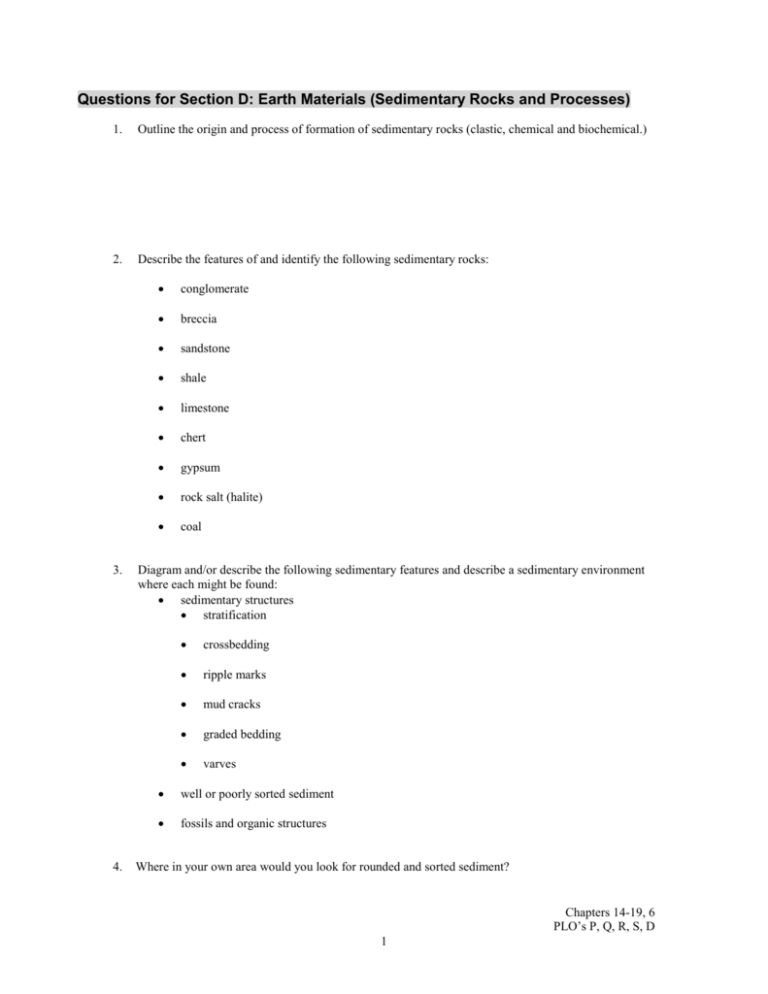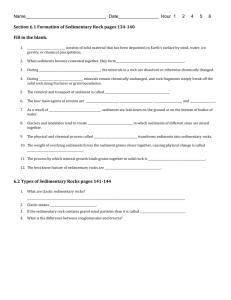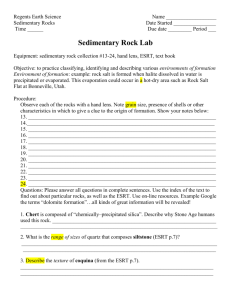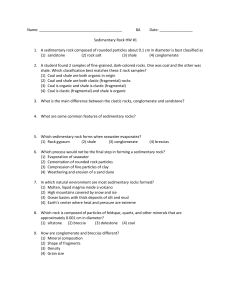File
advertisement

Questions for Section D: Earth Materials (Sedimentary Rocks and Processes) 1. Outline the origin and process of formation of sedimentary rocks (clastic, chemical and biochemical.) 2. Describe the features of and identify the following sedimentary rocks: 3. 4. conglomerate breccia sandstone shale limestone chert gypsum rock salt (halite) coal Diagram and/or describe the following sedimentary features and describe a sedimentary environment where each might be found: sedimentary structures stratification crossbedding ripple marks mud cracks graded bedding varves well or poorly sorted sediment fossils and organic structures Where in your own area would you look for rounded and sorted sediment? Chapters 14-19, 6 PLO’s P, Q, R, S, D 1 5. Explain why almost all sedimentary rocks are layered or bedded. 6. Sedimentary rock makes up a) about 5% of the Earth’s mantle b) less than 5% of the Earth’s crust c) 50% of the Earth’s crust d) 12% of the Earth’s core 7. The conversion of loose sediment to hard rock is called a) compaction b) precipitation c) lithification d) metamorphism 8. A clastic sedimentary rock has angular clasts ranging in size from 2 mm to over 100 mm. What is the name of this rock? a) Breccia b) Sandstone c) Conglomerate d) Shale 9. In which of the following environments would chemical sedimentary rocks likely form? a) Coastal deltas b) Restricted bays of warm, shallow water c) High energy beaches d) Deep sea floor 10. Which of the following characteristics of clastic rocks would provide the most useful information for determining the source area of the rocks? a) Rock name. b) Presence of mud cracks c) Composition of clasts d) Thickness of bedding 11. Which of the following is most likely to decrease during the lithification of sediment? a) Density b) Porosity c) Grain size d) Cementation 12. Which of the following sedimentary rocks would most likely contain fossils? (Why?) a) breccia b) gypsum c) limestone d) conglomerate 13. The best sedimentary classification of rock salt is a) clastic b) detrital c) organic d) evaporite Chapters 14-19, 6 PLO’s P, Q, R, S, D 2 Use the following diagram to answer questions 14 and 15 14. Where would you most likely find angular and poorly sorted sediments? Explain your answer. 15. Describe the sediment that would be found at Z. Use the diagram of a Series of Rock Units Exposed in a Cliff Section on the next page to answer questions 16 to 19 16. From the evidence shown, in which of the following sedimentary environments was Unit U most likely deposited? a) River b) Desert c) Alluvial fan d) Shallow marine 17. The rock unit which contains the best evidence of alternate flooding and drying is a) V b) W c) X d) Y 18. Which rock unit is composed of clastic sediments that have been transported the shortest distance? a) U b) V c) W d) X 19. Which rock unit could be mined and used for making fertilizer or cement? a) V b) X c) Y d) Z Chapters 14-19, 6 PLO’s P, Q, R, S, D 3 Chapters 14-19, 6 PLO’s P, Q, R, S, D 4 Use the following sequence of events to answer question 20 and 21 20. A sedimentary rock has formed at X as a result of the sequence of events shown above. This rock would most likely be a) chert. b) shale. c) siltstone. d) rock salt. 21. The sedimentary rock found at X would most likely be classified as a) an evaporate b) clastic c) well sorted d) organic 22. Which of the following is a sedimentary rock formed by the lithification of silt and clay? a) Shale b) Breccia c) Sandstone d) Conglomerate 23. Which of the following sedimentary rocks is a chemical precipitate? a) Sandstone b) Coal c) Chert d) Shale 24. Small, rounded grains composed of calcite are most often found in a) sandstone b) limestone c) shale d) mudstone 25. Small, spheroidal grains composed of quartz are found in a) sandstone b) limestone c) shale d) mudstone 26. Which of the following is not a clastic sedimentary rock? a) Conglomerate b) Sandstone c) Chert d) Shale Chapters 14-19, 6 PLO’s P, Q, R, S, D 5 27. A biochemical sediment consists largely of coral and shell debris. If this sediment were lithified, it would become a) coal b) chert c) limestone d) conglomerate 28. In which environment would coal deposits most likely form? a) River bed b) Coastal swamp c) Beach environment d) Deep ocean environment 29. If a beaker of seawater were left to evaporate and dry out, the minerals left present in the container would most likely be a) biotite and quartz b) gypsum and halite c) fluorite and galena d) calcite and chalcopyrite See next page for last question. Chapters 14-19, 6 PLO’s P, Q, R, S, D 6 Use the following features in the diagram below to answer question 30 30. a) Indicate a location where each of the features could form, by placing the letter of the feature on diagram 2. b) Describe how the features you have chosen were formed. Feature Description of how feature formed Chapters 14-19, 6 PLO’s P, Q, R, S, D 7









